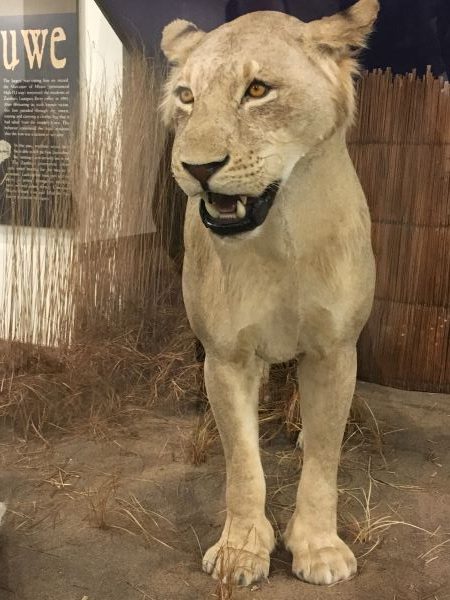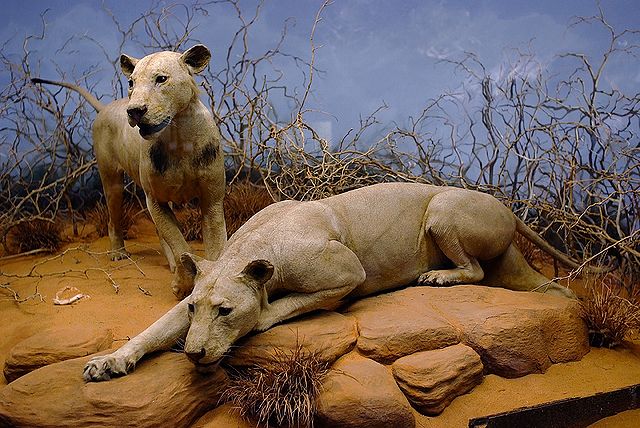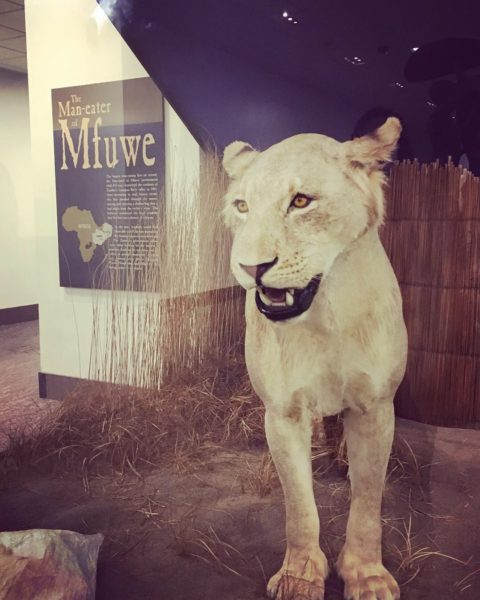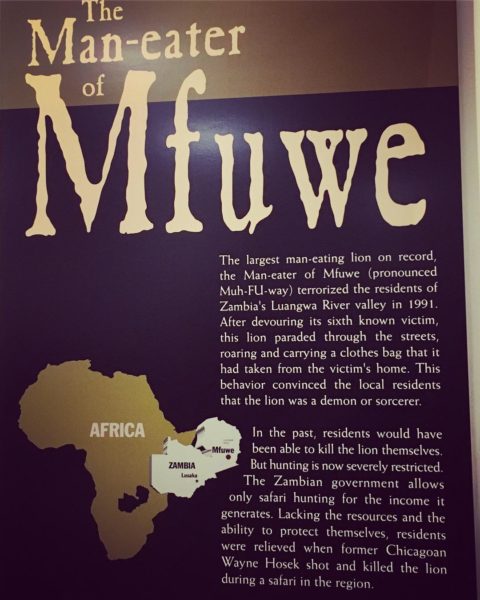
It was impossible not to think of “The Ghost” and “The Darkness,” the man-eating lions that inspired the movie of the same name, when I spotted “The Man-Eater of Mfuwe” on display in Chicago’s Field Museum. I’d never heard of the beast before then. Nor did I realize at the time that the museum also housed the taxidermied remains of the Tsavo man-eaters.
It wasn’t until I found myself back in the Windy City for another visit that I put the pieces together. I decided to consult Atlas Obscura for other cool and unusual things to see in the city that I hadn’t yet.
Boom. There it was. An entry for the Tsavo Man Eaters with the teaser, “These pretty kitties killed and ate as many as 135 railway workers.” (It might’ve been less than that, though. As with a lot of things, it depends on the source.)
Besides stalking human prey and ending up on display in the Field Museum, did the man-eating lions share anything else in common? Let’s check out their stories.
The Man-Eating Tsavo Lions

In 1907, John Henry Patterson published a book called The Man-Eaters of Tsavo. As its synopsis explains, “Patterson published Man-eaters in 1907 to describe his experiences building in a railroad bridge in Africa (in what is now Kenya). The man-eaters of the title refer to two lions, who reportedly slew over 130 people before Patterson shot them dead. Readers seeking to enhance the memoir’s effect can view the lion skins on display in Chicago’s natural history museum.”
Patterson was a British Army Colonel. In 1898, he was brought in to oversee the construction of a permanent bridge on the British Kenya-Uganda Railway across the Tsavo River. (It also earned the moniker “The Lunatic Line” because some said it ran “nowhere to nowhere.”) Work stopped when workers started disappearing. Except, they hadn’t simply “disappeared.”
People reported seeing lions, and suggested they were eating the workers, which Patterson at first discounted. Until they started finding human remains.
Natives named the pair “Ghost” and “Darkness” because they often hunted at night and were so stealthy about it. And brazen too. Even though workers built fires in camp that they kept lit all night and used the thorny branches of Acacia trees to construct fences, the lions knew food slept unawares within. They jumped the fences and pulled people right from their beds.
Under pressure to get the bridge complete, Patterson had no choice but to hunt the lions that relentlessly stalked the workers. He eventually killed them, and when he did, he used their hides as “trophy” floor coverings.
Which explains their rather “worn” appearance in the display at the Field Museum. After Patterson gave a presentation there in 1924, he sold the hides to the museum. Taxidermist Julius Friesser turned them into the bodies that have been on display in the museum ever since.
Something else interesting to note is that the lions are smaller than detailed in Patterson’s book. However, as Atlas Obscura noted, this “may have to do both with exaggeration or mismeasuring on his part and some trimming of the skins required, both for creating tidy rugs and later for fitting over three-dimensional taxidermy forms.”
Patterson also kept their skulls, which are also displayed with their bodies in their display case.
But how many people did the Ghost and the Darkness eat in the nine months they terrorized the railway workers? Well, the exact number remains unknown. Daily Kos reported that the railroad company estimated 28 whereas Patterson claimed 135.
However, it very well may be closer to Patterson’s number as a study from 2009 showed. Biologists conducted a chemical analysis on hair and skin samples taken from the lions. They used “isotope ratios to determine the chemical makeup of the proteins in the lion’s diet during their last months of life.” From that, they determined one of the lions had eaten about 11 humans and the other 24.
It didn’t specify how many of their last months of life that included, though. All nine that they terrorized the workers? Or just the last three or four? Depending on that answer, that’s why it could be upwards of 100 people they consummed.
The Man-Eater of Mfuwe

The Mfuwe man-eater didn’t kill as many people as the Ghost and the Darkness did. But his reign was terrifying while it lasted. Here’s the story from the information card with his display:
The largest man-eating lion on record, the Man-eater of Mfuwe (pronounced Muh-FU-way) terrorized the residents of Zambia’s Luangwa River valley in 1991. After devouring its sixth known victim, this lion paraded through the streets, roaring and carrying a clothes bag that it had taken from the victim’s home. This behavior convinced the local residents that the lion was a demon or sorcerer.
In the past, residents would have been able to kill the lion themselves. But hunting is now severely restricted. The Zambian government allows only safari hunting for the income it generates. Lacking the resources and the ability to protect themselves, residents were relieved when former Chicagoan Wayne Hosek shot and killed the lion during a safari in the region.

Did demons possess the man-eating lions?
In the movie The Ghost and the Darkness, one of the characters suggests the Tsavo lions are possessed by evil spirits. Which is also why I was reminded of them while reading the Mfuwe Man-eater’s info card.
So far in my research, I haven’t found anything that suggests natives or the railroad workers felt that way about the Tsavo lions. Although maybe Patterson mentions something about it in his book? Which I haven’t read yet. I knew the movie had been based on a true story, but it wasn’t until writing this that I realized that story had been captured in a book. So maybe it’s addressed there.
But the Mfuwe lion was definitely thought to be supernaturally influenced. I’m really not one to believe in demons, but in this case, I can see how it’d be easy to draw that conclusion. What about you?
Check-In
Do you think demons can possess animals too, or just humans?
Courtney Mroch is a globe-trotting restless spirit who’s both possessed by wanderlust and the spirit of adventure, and obsessed with true crime, horror, the paranormal, and weird days. Perhaps it has something to do with her genes? She is related to occult royalty, after all. Marie Laveau, the famous Voodoo practitioner of New Orleans, is one of her ancestors. (Yes, really! As explained here.) That could also explain her infatuation with skeletons.
Speaking of mystical, to learn how Courtney channeled her battle with cancer to conjure up this site, check out HJ’s Origin Story.

If a big cat killed just one person it’d be a scary creature. I do think demons can inhabit animals because of the swine in the Bible, but I think it’s rare, like exorcism rare. It wouldn’t make sense for God to allow demons to hop into innocent animals willy-nilly.
Your last sentence made me LOL IRL! Agreed!